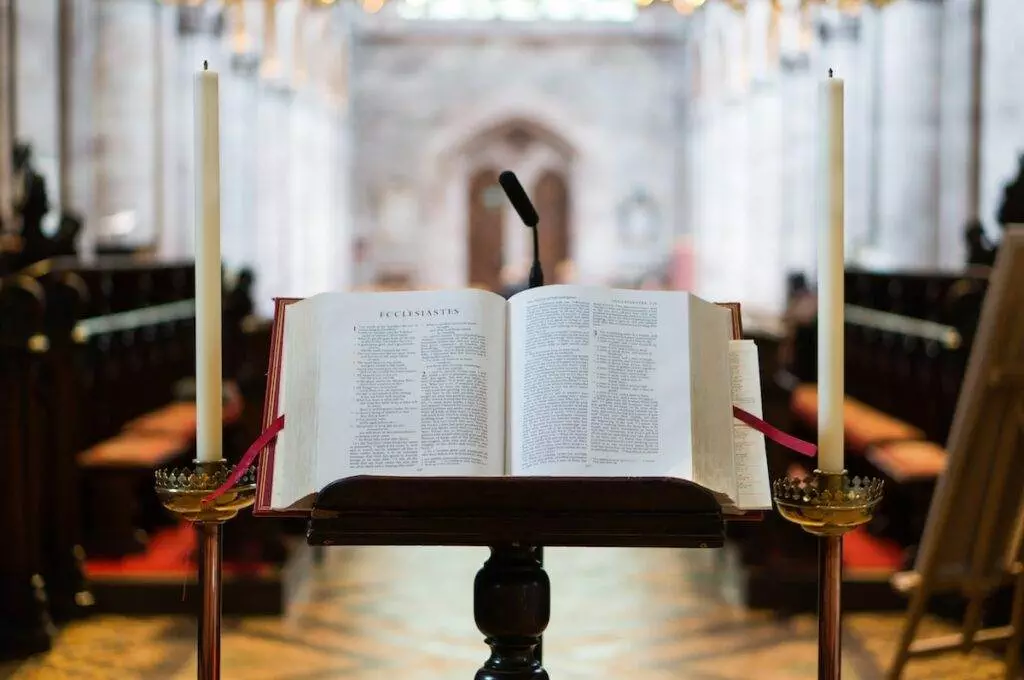Christianity had a profound impact on Old and Middle English literature, shaping the themes, characters, plots, and literary techniques of many canonical works. The conversion of Anglo-Saxon England to Christianity began in the 7th century and was largely complete by the 8th century 1.
Table of Contents
Major Old English literary works with Christian influences include Beowulf, The Dream of the Rood, Caedmon’s Hymn, and poems by Cynewulf. In Middle English literature, Geoffrey Chaucer, William Langland, the Pearl Poet, and Julian of Norwich created important literary works steeped in Christian theology and biblical allusions.
From the elegiac poems of the Anglo-Saxons to the morality tales of the medieval period, Christian doctrine fundamentally molded the literary consciousness of early English authors. This essay will analyze the varied manifestations of Christian thought, narrative, and symbolism within the seminal literature of the Old and Middle English periods.

Religious Themes in Old and Middle English Literature
Biblical and Christian themes like salvation, sin, and redemption are prevalent in major Old English works like Beowulf and The Wanderer. The epic poem Beowulf contains many allegorical references to the Bible, with the titular character Beowulf exhibiting Christ-like qualities of humility and self-sacrifice in his battle against the monster Grendel [paperowl source].
There are also evocations of Cain and Abel in the Grendel character, who is portrayed as an outcast descendant of the biblical Cain. The ideas of fate and divine providence, as seen through the Christian lens, also feature prominently in the poem.
Meanwhile, the elegy The Wanderer contains heavy use of allegory and symbolism to explore themes of sin, punishment, and redemption. The wanderer character is an allegorical figure facing exile and hardship due to unspecified sins, but holds on to the hope of redemption by relying on his Christian faith and values [2nd source]. The harsh journey of the wanderer thus symbolizes the larger spiritual journey of man through suffering and repentance.

These major Old English works exemplify how biblical and Christian concepts were blended with existing heroic values to produce a distinctly English Christian literature and worldview. The use of allegory and symbolism was crucial in conveying these religious themes to a society still in transition to Christianity.
Religious Characters in Middle English Literature
Medieval England was dominated by Christianity and Christian themes (An Introduction to the Medieval English). As such, Middle English literature features many prominent religious characters and archetypes that embodied Christian virtues and vices.
One of the most well-known Middle English works is Geoffrey Chaucer’s Canterbury Tales, which contains several pilgrim characters representing different social classes and temperaments. The Parson and the Plowman stand out as the most virtuous, portraying ideals of piety, charity, and humility. Meanwhile, the Pardoner is depicted as greedy and hypocritical in his abuse of relics for profit (Middle English literature).
In Sir Gawain and the Green Knight, Gawain strives to fulfill the chivalric code and embody such Christian virtues as courage, honor, and courtesy. Yet he struggles with the human imperfections of cowardice and dishonesty when tempted by the lady of the castle. His flaws make Gawain a more complex religious character.
Other characters like Everyman in the morality play of the same name represent broader religious archetypes. As an allegory for all of humanity, Everyman grapples with choosing faith and doing good works over materialism as he faces death. His journey provides a Christian perspective on morality and salvation.

By analyzing characters like the pilgrims, Gawain, and Everyman, we can better understand how Middle English writers used religious figures to both teach and reflect Christian values and beliefs. Their flawed yet earnest characters brought biblical principles to life in a relatable way for medieval audiences.
Morality and Didacticism
Much of medieval literature aimed to impart moral lessons on Christian principles to medieval audiences. Didactic works were written with the express purpose of educating people about religious doctrine and promoting moral behavior aligned with Christian values 1.
The most common forms of didactic medieval literature were homilies, exempla, and fables. Homilies consisted of sermons analyzing scripture and expounding on its moral meaning. Exempla were short moral anecdotes used to illustrate a religious or ethical lesson. Fables featured animal characters and ended with an explicit moral. All aimed to teach Christian morality in an accessible, memorable format 2.

One of the most famous examples of didactic medieval literature is the morality play Everyman. Morality play depicted allegorical figures representing virtues and vices engaged in a spiritual struggle for a protagonist’s soul. The morality play aimed to teach moral lessons about choosing Christian virtues over worldly vices. In Everyman, the main character must undertake a journey to death and seek aid from figures such as Knowledge, Discretion, and Good Deeds 3.
Biblical Allusions and Analogues
Biblical narratives, imagery, and symbolism were ubiquitous in medieval English literature. Writers frequently made allusions to biblical stories, characters, and morals as a way to imbue their works with gravitas and familiar cultural touchstones.
One major way biblical references appear is through direct parallels between literary characters and biblical figures. According to the Biblical quotations in Middle English literature before 1350, Eve, Judas, Pontius Pilate, and other biblical personalities are referenced in Middle English works as archetypes. For example, Judas is mentioned as a symbol of the betrayer in both religious and secular medieval texts. References to Adam and Eve were used to explore themes of temptation and sin.
Biblical plots also served as common narrative structures for medieval English writers to build upon. The Middle English poem Cleanness, for instance, contains three sections that use Noah’s Flood, the destruction of Sodom and Gomorrah, and the biblical tale of Belshazzar’s Feast as allegories about morality and God’s wrath against sin. Each section adapts these Old Testament stories to give moral lessons to the reader.
Finally, biblical symbolism infuses the poetics of medieval English literature. The Bible in Middle English Literature notes that numbers like seven and twelve carried symbolic meaning derived from scripture. Images of light and brightness were used to represent spiritual purity, while darkness was equated with damnation.
Trees, flowers, and kosher animals were symbols of righteousness, while beasts like serpents and swine connoted sin. Medieval writers relied heavily on these biblical symbols as literary shorthand to convey moral and spiritual meaning.
Christian Literary Forms and Techniques
Christians writers in the Middle Ages drew heavily on biblical exegesis and Christian traditions, developing distinctive literary forms, techniques, and genres. Allegory was commonly employed to convey spiritual meanings, following the exegetical practices of reading scripture for its figurative and symbolic senses beyond just the literal.
Works like Prudentius’s Psychomachia personified virtues and vices in allegorical battle. Biblical typology also shaped literary forms, as Old Testament figures and events were seen as prefigurations or types pointing towards Christ.

Medieval hagiographies recounting saints’ lives, Marian lyrics praising the Virgin Mary, and mystery plays dramatizing Bible stories all represent genres emerging from the Christian context. Religious writings and sermons provided rhetorical models that influenced literary style as well. For instance, Cynewulf’s poems or Ælfric’s homilies adapt the lofty Latinate prose and figures of speech found in patristic texts.
Rhymed prose (cursus) and balanced clauses (periodic style) characteristic of ecclesiastical Latin prose appear transposed into Old English. The alliterative verse of poems like Beowulf or The Dream of the Rood likewise owes its rhythmic style partly to the rhetorical patterns of Latin liturgical poetry.
Overall, medieval English literature was profoundly shaped at all levels by Christian forms, tropes, genres, and stylistic techniques adapted from biblical exegesis and earlier ecclesiastical writings.
Conclusion
Christianity had a profound influence on early English literature. As discussed throughout this piece, religious themes, characters, morality tales, biblical references, and Christian literary forms permeated Old and Middle English works.
The spread of Christianity in Anglo-Saxon England brought with it literacy, new poetic forms like rhymed verse, and an emphasis on didacticism. Major Old English poems like Beowulf incorporated Christian elements alongside pagan ones. Middle English writers frequently used allegory and symbolism inspired by the Bible.
In summary, the advent of Christianity fundamentally shaped the themes, characters, and techniques of early English literature. Without the influence of the church and Christian thought, Old and Middle English works would likely have developed much differently.
Understanding the pervasive role of Christianity is key to analyzing early English poetry, prose, and drama in their proper historical context. The English literary canon owes much to the cultural intermingling between pagan Anglo-Saxon traditions and Christian beliefs and forms.


